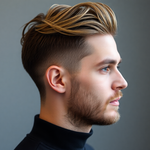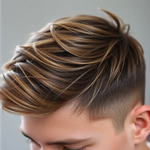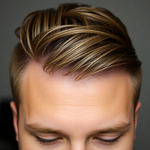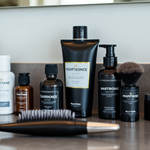
Semi-Permanent Hair Color as a Style Tool: How to Use Hair Shade Mapping to Expand a Minimal Men's Capsule Wardrobe
19 October 2025
Share
Intro — A quick style hack that actually works
Semi-Permanent Hair Color can be the fastest way to upgrade a minimal capsule wardrobe without adding clutter or breaking the bank. If you’ve got 8–12 core pieces but feel like your look needs a refresh, using hair shade mapping to coordinate tone and contrast gives you instant variety and sharper outfits. Read on for step-by-step mapping, shade picks by skin tone, maintenance tips, and real-world pairing ideas you can use this week.
Why Semi-Permanent Hair Color works as a style tool
Semi-permanent color deposits pigment without strong developers, which means lower damage, easier changes, and a fade-out timeline that lets you test looks across seasons. It’s subtle when you want subtle, and it can read bold when you need presence — perfect for men who prefer a curated capsule over an overflowing closet.
- Low-commitment experimentation: try tones for 4–8 weeks before they fade.
- Texture and contrast: highlights and lowlights add depth so simple pieces look layered.
- Face framing: the right shade enhances skin tone and draws attention where you want it.
- Cost-effective refresh: color + one or two key accessories = new outfit energy.
What is hair shade mapping?
Hair shade mapping is a strategic approach to choosing hair tones that intentionally harmonize with the colors, textures, and moods of your capsule wardrobe. Instead of guessing what looks "cool," you map shades to clothing palettes so the hair becomes another styling tool — like a shoe or a jacket — that defines multiple outfits.
Hair shade mapping — step-by-step
- Audit your capsule: Lay out your core items (8–12 pieces). Note primary colors, accent colors, and the dominant materials (denim, knit, leather).
- Identify the mood: Is your capsule rugged, clean-minimal, preppy, or streetwear-forward? Mood narrows shade families.
- Choose three candidate tones: Pick a base (natural), an accent (highlights or lowlights), and a statement (deeper/warmer/different tone). Examples: ash brown (base), cool highlights (accent), muted blue-black (statement).
- Strand test: Apply a semi-permanent swatch to a hidden strand. Check it next to your most-worn jacket or tee in natural light.
- Decide method: All-over gloss for uniformity, subtle balayage for texture, or root smudge for low-maintenance contrast.
- Document combos: Take outfit photos after dyeing to build a lookbook of what works.
- Plan refreshes: Semi-permanent fades; schedule touch-ups or color-depositing masks every 3–6 weeks depending on intensity.
Semi-Permanent Hair Color: shade picks by skin tone and capsule palette
Below are practical starting points. Always do a strand test — everyone's hair and skin are unique.
- Cool undertones + monochrome/minimal capsule (black, greys, white): Ash brown, cool espresso, or blue-black. These reinforce the clean, modern aesthetic and work well with structured outerwear.
- Warm undertones + earthy capsule (olive, tan, rust): Warm chestnut, honey brown, or soft copper — these tones bridge clothes and complexion for an intentional autumnal look.
- Olive skin + urban streetwear (denim, charcoal, olive): Muted smoky blue-black or dark ash brown keeps edge without looking costume-y.
- Fair skin + classic/navy capsule (navy, cream, camel): Light caramel highlights or golden brown lifts the face and adds approachable contrast.
- Darker skin tones + bold color accents in wardrobe: Deep espresso or warm chocolate tones enhance richness and let accent colors pop.
How to pair shades with staple pieces
Think of hair like another garment — it should balance or accent your outfit. These pairings are quick cheats you can apply immediately:
- Structured coat (navy or charcoal) + ash brown or cool espresso: Sharper, more professional appearance.
- Olive field jacket + warm chestnut or copper highlights: Natural, cohesive, and intentionally rugged.
- Monochrome black capsule + muted blue-black: Elevated urban look that reads intentional at night.
- Navy sweater + golden highlights: Brightens the face and complements classic menswear tones.
- Denim jacket + lowlights/highlights: Adds texture and depth so casual fits don’t look flat.
Real-world styling scenarios
Picture this: You have a first date with a smart-casual vibe — navy jeans, white tee, charcoal overshirt. A rich, cool espresso connects to the navy and sharpens the white tee, making you look intentional without trying too hard.
Here are three expanded scenarios with concrete choices:
- Weekday office / client meeting: Option: deep ash espresso. Outfit: tailored chinos, white oxford, navy blazer. Why: the cool tone signals polish and keeps attention on your face.
- Weekend coffee / daytime dates: Option: warm chestnut with subtle caramel highlights. Outfit: olive chore jacket, tan chinos, clean white sneaker. Why: warmth complements casual textures and looks approachable.
- Evening out / creative event: Option: muted blue-black or smoky blue. Outfit: black jeans, monochrome tee, leather jacket. Why: higher contrast and a touch of edge when you want to be remembered.
Application methods: salon vs at-home
Semi-permanent hair color is available in boxed home kits and salon formulas. Here's when to choose each:
- Salon: Best for dimensional work (balayage, face-framing, multi-tone mapping) or when shifting several levels/directions. Stylists can map placements to match collars, hoods, and jacket silhouettes for a pro finish.
- At-home: Great for all-over gloss, slight tone shifts, or refreshes with color-depositing masks. Choose trusted brands that specify no peroxide developers for less damage.
When in doubt, book a consult. If you want dramatic placement—highlights that peek from under a beanie or lowlights that show under stage lights—a pro will map it to your wardrobe and face shape.
Maintenance, products, and safety
Maintaining semi-permanent color is easy if you follow a few smart habits:
- Use sulfate-free shampoos and color-safe conditioners to slow fading.
- Swap to a color-depositing conditioner or mask weekly to refresh tone without re-dyeing.
- Avoid daily hot showers and reduce heat styling; heat and hard water accelerate fade.
- Protect hair from sun and chlorine with UV-protectant sprays when needed.
- For sensitive scalps or chemical concerns, review safety guidance from medical sources — WebMD’s hair dye safety guidance is a practical reference: WebMD: Hair Dye Safety.
Suggested routine:
- Wash 2–3x per week with cool-to-lukewarm water.
- Use a color-depositing mask every 2–3 weeks to maintain hue intensity.
- Trim every 6–8 weeks to keep ends healthy and color looking fresh.
Styling tools and product picks
Look for these items in your grooming kit:
- Color-depositing conditioner or weekly mask (match the tone family).
- Sulfate-free, pH-balanced shampoo for colored hair.
- Heat protectant spray — essential if you use blow-dryers or hot tools.
- Matte paste or light cream to style and reveal lowlights/highlights texture.
Brand values: sustainability and selecting products
If sustainability matters to you, seek semi-permanent lines that prioritize lower-impact formulas (less peroxide, recyclable packaging, cruelty-free). Menll.com’s focus on quality and conscious production pairs well with a simple grooming philosophy: fewer, better items. A well-chosen Menll.com outerwear piece ties a hair change into an entire look — check the outerwear collection for structured pieces that play nicely with darker, more defined hair tones: Menll.com outerwear.
Troubleshooting & FAQs
- Too brassy/fades warm: Use a cool-toned color-depositing mask or ask your stylist for an ash glaze.
- Fades too fast: Cut back wash frequency, switch to color-safe products, and use a deposit mask.
- Sensitivity after application: Stop use and consult a professional; patch tests are worth doing before full application.
- Color mismatch: If the chosen tone doesn’t read right with your wardrobe, document what didn’t work and adjust — cooler or warmer by one step usually fixes it.
Before you commit — quick checklist
- Do a strand test next to favorite pieces in daylight.
- Decide on application method (gloss, balayage, root smudge).
- Buy maintenance products before you dye (sulfate-free shampoo, mask).
- Take "before" photos for reference and to show your stylist.
- Plan a touch-up cadence — semi-permanent needs scheduled refreshes.
Final thoughts — small change, big returns
Semi-Permanent Hair Color is one of the highest-ROI moves for men who favor a minimal wardrobe. With hair shade mapping, you can extract new outfit potential from the same core pieces, express mood changes across seasons, and stay low-commitment while exploring style. Try one mapped change this month: test a strand, match it to one jacket and one tee, and see how many new looks you can create.
What shade will you try first with your capsule? Share in the comments or browse Menll.com for wardrobe staples that pair with your new tone.
Prev post
Next post

Step-by-Step Semi-Permanent Hair Color System to Multiply Looks from a Minimal Men's Capsule Wardrobe
Updated on 18 October 2025






